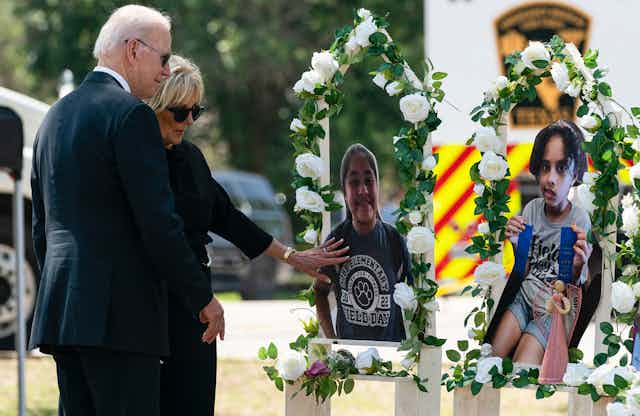I had always been afraid of America. Once, in Alaska, we had dinner with a man my father was working with, and he had actually uttered the line – that iconic American saying, so ridiculous as to be almost unbelievable. Guns don’t kill people. People kill people. I thought he was joking, attempting some kind of irony. He wasn’t.
When I got a fellowship at Yale a decade later, a big part of me did not want to go, and especially did not want to take my husband and our almost-two-year-old daughter with me.
Going on to a school or college campus in the United States is demonstrably risky.
The Wikipedia category page listing school shootings in the United States already has 22 entries for 2022 alone.
Still, I wasn’t afraid enough not to go. Or perhaps I was just more afraid of what people would say if I said I wasn’t going to Yale because of guns. The pull of America is strong, even to those who know.
Read more: Will the latest shooting of US children finally lead to gun reform? Sadly, that's unlikely
On Tuesday last week, it happened again.
An 18-year-old gunman entered an elementary school in Ulvade, Texas, and shot and killed 19 children and two teachers. The children were all nine and ten years old. The police didn’t help them.
Over the weekend, an 11-year-old girl explained to the media that she had survived by smearing the blood of her dead friend over herself and pretending that she was dead, too.
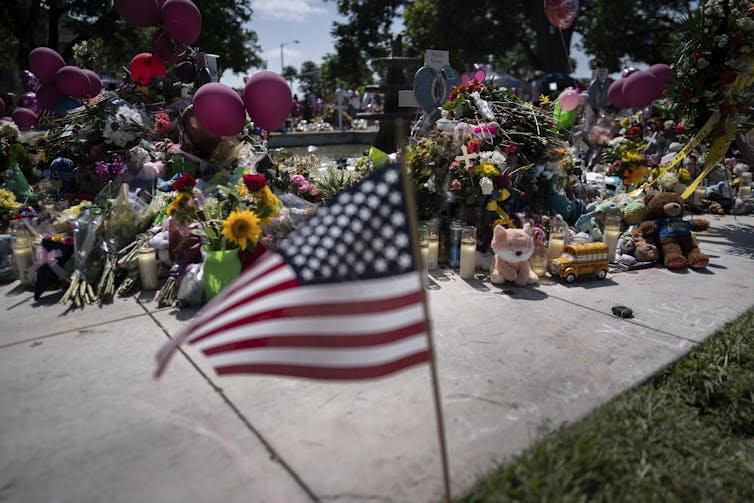
The conversation is the same. The National Rifle Association held its convention a few days after the shooting, in Houston. Texas Senator Ted Cruz said, “We must not react to evil and tragedy by abandoning the Constitution or infringing on the rights of our law-abiding citizens.”
The beacon of democracy and freedom, the shining light on the hill, the force for good in the world, can not, will not, protect its own children.
Child’s play in gun country
On one of our last days in New Haven, in the northern summer of 2018, I took my daughter to the Yale Peabody Museum of Natural History. Like everything at Yale, the museum is extraordinarily well funded. It’s free for Yale students, and is always hosting community events, mostly for local school children.
On that particular day, one of the first real days of New England summer, when the green had exploded and the air was thick with humidity, the museum was quiet. We spent what felt like hours in the children’s discovery room, listening to the elderly volunteers worry about the black mould in the leafeater ant colony and marvelling at the poison dart frogs.
I held my daughter’s hand as we walked down the grand stone staircase, under the watchful glass eyes of the pink giant squid, to see the fossils. I chuckled, again, at the glorious 1940s mural that spanned the length of the Great Hall and its red-eyed, cartoonishly angry Tyrannosaurus Rex. Clara ran around and around the main display, insisting on touching the fake rocks even though she knew she shouldn’t, yelling at the top of her lungs. “Rrrrraaaa Mummy, I’m a dinosaur, rrrraaaa!”
For some reason, as Clara did her little dino routine, I looked up, and noticed two boys watching from the discovery room above. They were both white: nine, maybe ten. As I watched, one of the boys, standing right in the middle of the window, pretended to cock a shot gun. He lowered it slowly, while his little friend laughed, and proceeded to shoot everyone in the hall below. Shoot, reload, shoot, reload. He shot my daughter as she ran laps around the brontosaurus.
It was pretend. I knew it was pretend. But I could barely stand. I was frightened, of course. But it was the vicious rage that nearly knocked me down. Rage at the kid standing in the window, at his friend, at their parents, their grandparents. All of them.
This fucking country.
Read more: 6 charts show key role firearms makers play in America’s gun culture
Parkland and a student revolution
On campus, there were regular reminders of the danger: bag searches before lectures, or complete bag bans in the case of particularly important speakers like Henry Kissinger or Al Gore. Yale was relatively safe, of course, insulated by privilege. But everyone operated under the assumption that it was only a matter of time until the next one, even if it was more likely to be somewhere else.
We arrived in New Haven in August of 2017. The next mass school shooting happened on February 14, 2018. If anything, we waited longer than we had anticipated.
On that winter day, a 19-year-old man walked into Marjory Stoneman Douglas High School in Parkland, Florida, and shot and killed 17 people with a semi-automatic weapon. 14 of those victims were aged between 14 and 17 years old. 17 others were seriously injured. The gunman had purchased the AR-15 he used legally. It was the worst school shooting in American history.
In the US, Parkland, and the extraordinary young survivors who became the face of a movement, dominated the news for weeks. Through their activism, those students, along with organisations like Moms Demand Action, have seized the narrative, and are doing everything they can to create change.
In the month after the Parkland murders there were huge protests all over the country. In the “March for Our Lives”, half a million kids descended on Washington, DC, with Parkland survivors at the forefront. Children all over the US walked out of school, supported by organised events in basically every city in the country.

Parkland has largely fallen off the mainstream radar, now. It reappears periodically, more often than not because one of the young survivors, traumatised by this hideous act of cruelty, has decided they cannot take it anymore. Other survivors are forced to publicly relive their trauma, again, whenever there is another one. Because despite the appalling public suffering of those children and their extraordinary organising, the shootings have not stopped.
Since Parkland, there have been many more mass shootings in the US, in schools and elsewhere. By one count, there were 417 mass shootings (defined as an incident in which four or more people are killed) in 2019 alone. In the following year – in fact, before 2020 was even over – Americans had purchased more guns than in any of the years before: 17 million. 17 dead teenagers. 17 injured. 17 million more guns.
Toxic American gun culture is a hideous outgrowth of American exceptionalism, and just like that exceptionalism, there is nothing else like it in the world. In any other Western country, when white kids die, something happens.
But at Parkland, at Sandy Hook, at Virginia Tech, at Columbine, the kids who died were mostly white. They were seemingly middle class. The fact that white, privileged children are being killed and nothing is being done about it is extraordinary, in the truest sense of the word. The American political system – built on, and sustained by, white supremacy – is willing to sacrifice its children to keep its guns.
Those guns have become symbols of that white supremacy, as conservative forces in the American media encourage and spread the same hateful, violent ideologies that meet their logical endpoints in supermarkets in Buffalo, as they have since even before the nation was founded. The suffering Americans willingly inflict on each other, on their own children, is as horrifying as it is mundane.
But it wasn’t always this way.
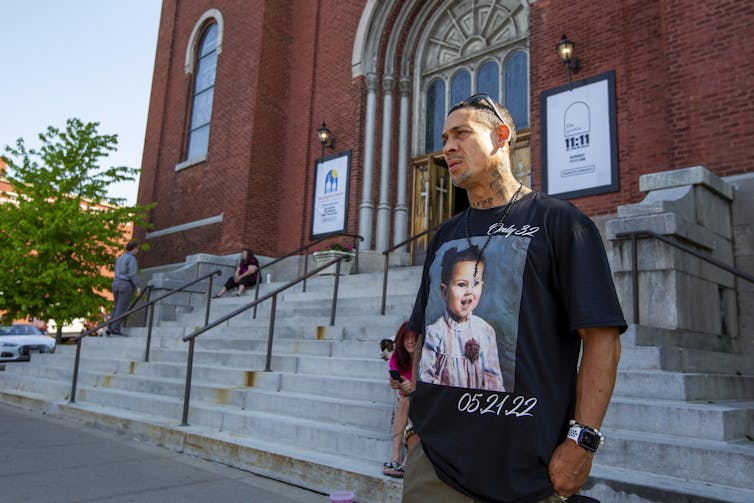
The Second Amendment, Reagan and racist politics
The Second Amendment to the US Constitution forms the centrepiece of American gun culture and conversations about how to dismantle it. It is one of the ten amendments to the Constitution which form the Bill of Rights, ratified in 1791. Its words are no doubt familiar, but they are worth repeating:
A well-regulated Militia, being necessary to the security of a free State, the right of the people to keep and bear Arms, shall not be infringed.
The amount of ink spilt in legal, philosophical, historical and political debates about the true meaning of those 27 words defies assimilation. What is inarguable is that those words were composed by white men worried not so much about an individual’s right to buy and use the kind of weaponry their 18th-century minds could scarcely imagine, but about protecting the political revolution they had led and institutionalised.
The Second Amendment reflected contemporary fears that a standing army, in service to the state, would present an unacceptable threat to true freedom. (A freedom that, it must always be pointed out, was reserved only for white people.)
It did not anticipate that the standing army of the new nation would go on to become, two centuries later, the biggest and most dangerous in the world, or that it would feed into the vicious circle of American militarism.
The men who wrote it did not anticipate that it would be used to excuse the murder of American children. Their indifference to the murder of children they would not have considered American – Black Americans, Native Americans – must sit at the heart of any attempt to historicise the Second Amendment and its consequences.
But that amendment’s morph into a unique political monster was not inevitable, and is in fact fairly recent. Until the 1980s, interpretations of the Second Amendment tended not towards permissiveness, but to control. In the 1930s – a century and a half after the ratification of the Bill of Rights – both the federal government under President Franklin Roosevelt and the Supreme Court actually curtailed gun rights.
In the late 1960s, in the aftermath of the successive assassinations of President John F. Kennedy, Dr Martin Luther King, Jr and Senator Robert F. Kennedy – and, critically, the rise of the Black Panther movement – the Johnson administration oversaw the passage of the 1968 Gun Control Act.

For decades, gun control measures were successful at least in part because they were aimed at curtailing the ability of Black people to own guns. Not uncoincidentally, from its founding in 1871 until the mid-1970s, the National Rifle Association offered mostly bipartisan support to gun control measures.
It was not until the mid-1970s that gun culture and the role firearms play in American politics began to resemble what we are familiar with today. As the NRA radicalised, it built enormous political force. In 1980 the NRA endorsed a presidential candidate for the very first time – Ronald Reagan. Reagan had largely been in favour of gun control measures precisely because they were aimed at disarming African Americans. But by the 1980s, that had changed.
During Reagan’s second term, Congress passed the 1986 Firearm Owners Protection Act, which did exactly as its name suggests. Even an assassination attempt on that most beloved of NRA Presidents five years before did not shake what was quickly becoming an entrenched politics of gun rights, particularly on the right. Four decades ago, the Republican Party became the party of the NRA, and it remains so today.
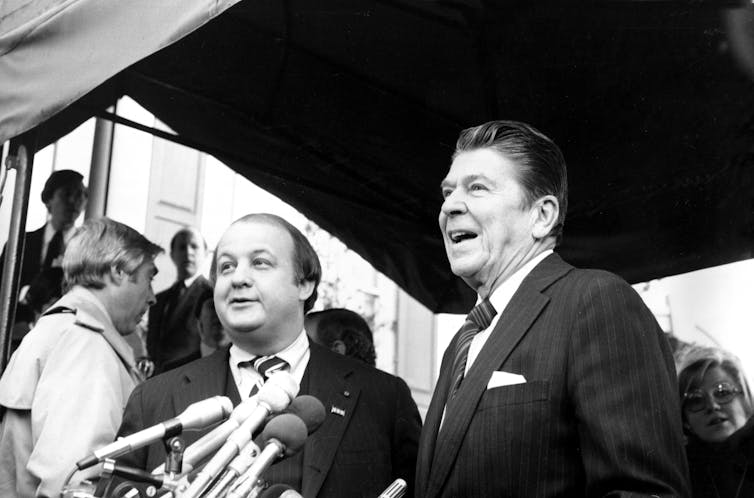
Clinton’s assault weapons ban
But at the end of the Reagan era, as a triumphant US emerged victorious from the Cold War and the 1990s promised a new era of American ascendancy, things looked like they might change. A new president sought to emulate his Democratic forebears in successfully enacting significant gun control measures.
In 1993, President Bill Clinton signed the Brady Handgun Violence Prevention Act, which created a national register of background checks. The following year, the Public Safety and Recreational Firearms Use Protection Act – more commonly known as the assault weapons ban – was passed as part of the infamous omnibus Crime Bill of 1994. The Act specifically banned military-style semiautomatic weapons.
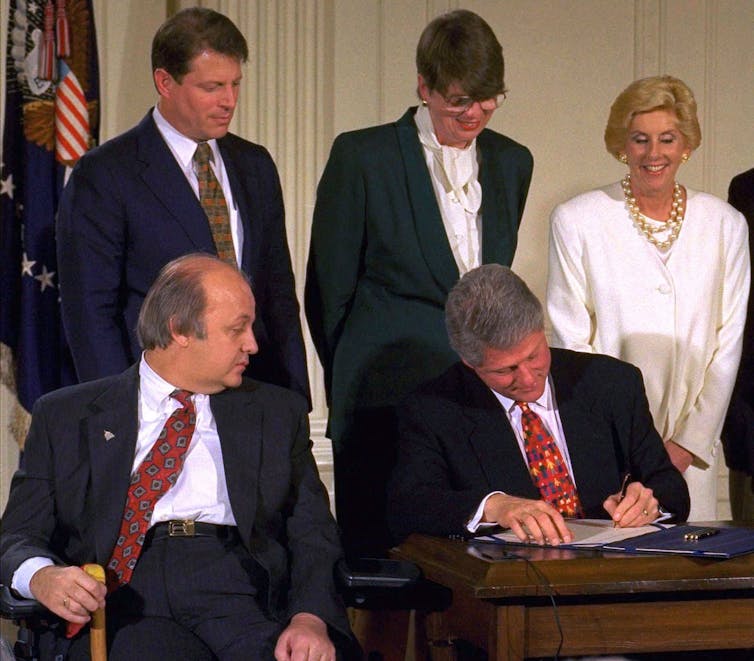
The NRA – which had spent an eye-watering (at the time, anyway) $1.7 million trying to get gun-friendly congresspeople elected – vowed electoral revenge.
But in this new era, coverage mused that maybe the NRA’s electoral influence was, at long last, waning, and in the new political culture of the 1990s, technocratic bipartisanship seemed to be winning out. Jimmy Carter and Ronald Reagan had written to Congress in support of the ban. It passed the House and the Senate easily.
But the promise of the 1990s was always an illusion. Clinton’s assault weapons ban did not signal a systemic change in American gun culture so much as a brief interregnum. The ban was full of loopholes and included what would turn out to be a catastrophic sunset clause. The Act came into force in September 1994 and lasted for a decade. It was not renewed.
Attempts to revive it have repeatedly failed. And even before it had expired, it was clear that it had not worked to prevent mass shootings.
Columbine: the first televised mass shooting
On April 22, 1999 – over four years before the assault weapons ban expired – two teenaged gunmen shot and killed 12 students and two teachers at Columbine High School in Colorado. Inspired by Timothy McVeigh and the Oklahoma bombing, they had planned the attack for a year.
McVeigh and his apprentice were both white supremacists, motivated by extreme right-wing views – including a hatred for federal government – that took on a new virulence during the Clinton presidency. That connection is largely forgotten, now.
Columbine – in fact deeply connected to the racist history of both the gun rights movement and the US political system – was far from the first mass shooting, and far from the last. But it was the first to be televised. Columbine became the first in a long line of what has become an all-too-familiar international spectacle of unfathomable grief and astounding political failure.
Columbine did not shake American gun culture. The reluctance to really reckon with Columbine – to recognise and address the systemic failures that allowed it to happen – has meant that the pattern continues. Though at the time it seemed such a cataclysmic event that the idea it would not lead to some kind of reform was unfathomable to those of us watching from afar, Columbine was very quickly attributed not to structural failures, but to errant individuals, high-school bullying, and video games. Just as Ted Cruz scrambled to blame Uvalde not on gun laws, but on insecure schools, calling for them to “harden” up and have just one door (with armed guards) accessible to the outside.
Since Columbine, aside from Michael Moore’s successful effort to get Walmart to stop selling ammunition, nothing much changed – and even that small victory didn’t last.
Since Columbine, the failures have piled up, like the dead bodies at Virginia Tech (2007), Fort Hood (2009), Aurora (2012), Charleston and San Bernadino (2015), Orlando (2016), Las Vegas (2017), Parkland (2018), and now Ulvade (2022).
Defying logic and compassion
There is no clearer example of the failure of American democracy than this incomplete list of massacres. Over 60 per cent of Americans are in favour of some kind of gun control measures, such as background checks or a ban on military-grade assault weapons. The failure of Congress, the presidency, and the courts to prevent these ongoing tragedies – and at times their efforts to make it easier for them to occur – defies all logic and compassion.
In recurring debates over gun control, Americans and international observers alike turn their eyes beyond American shores – more often than not, across the Pacific to Australia, and more recently, New Zealand.
Not long after President Clinton oversaw the passage of the temporary assault weapons ban in the US, a lone gunman massacred 35 people in Port Arthur, Australia. As the American version of the story goes, the public outpouring of grief and anger after that already rare event created what The New York Times has described as a “national consensus” that gun control was the answer.
The subsequent reforms – enacted by a conservative government – are described in alternatively incredulous and envious terms. But even the Times can’t resist importing American debates into its coverage of Australia, mischaracterising a national “debate” about gun reform around the nature of the controls and their legacy.
But the implied logic, the rationality, of Australian reforms, and later, Jacinda Ardern’s in New Zealand, is unmistakable. So too is the deep sense of resignation that such reform is not possible in a country so burdened by the unique nature of its foundation and politics. Ardern got a standing ovation at Harvard last week, after giving a speech about gun control. It won’t change a thing.
What Australians and New Zealanders fail to understand when we ask ourselves why Americans can’t just do what we did is the nature of American exceptionalism, its depth, and how it defies rationality.
We can recite our own national statistics all we like – Americans do the same. Scots, New Zealanders and Australians, with their hearts in the right places, do it after every massacre, and we will do it after the next one, and the one after that.
American parents will be forced, again and again, to share their grief with millions of viewers on cable television. Even before Ulvade, it was easy to imagine the new president, so accomplished at mourning, shedding his own entirely genuine tears at the first school shooting that occurred under his administration. It is also easy to imagine that, just like his predecessors, he won’t change a thing.
Australians should never pretend that we have the answers to the failures of American gun control. It isn’t helpful, or kind, when smug Australians look condescendingly at the US and its failures to rationally address its own deeply embedded and violent culture.
We tend to underestimate the power of the NRA, which has the entire Republican Party and too many Democrats on its payroll. A lot of us underestimate the power of American white supremacy. We also underestimate American reverence for the Bill of Rights and the Constitution, from those opposed to gun control and those in favour.
Americans, meanwhile, tend to overestimate the power of the NRA, and have allowed that power to become self-perpetuating. The NRA is powerful because it has created a narrative which sees that power as permanent and unshakeable. Combined with the force of American exceptionalism, that power – real and imagined – leads not to action, but to resignation and acceptance among the very people who are in a position to change things.
American institutions are seemingly powerless to enact gun reform because so many Americans believe – consciously or not – that any cost or sacrifice is worth it to live in the best country in the world. Even the potential massacre of their own children.
Read more: US shootings: Norway and Finland have similar levels of gun ownership, but far less gun crime
An elite inured to violent death
Yale University is full of immensely powerful and influential people, and people who will go on to hold positions of immense power and influence. Four out of the nine Supreme Court Justices — including Trump appointee Brett Kavanaugh — are graduates of Yale Law School (the other four went to Harvard; Trump’s final appointment, Amy Coney Barrett, went to Notre Dame). Five Yale alumni have gone on to become president (Bill Clinton, George H.W. Bush, George W. Bush, Gerald Ford, and William Taft).
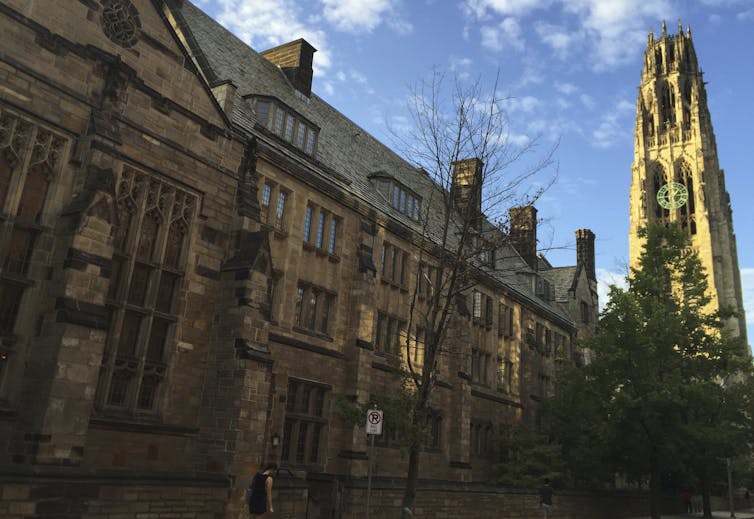
Yale graduates are everywhere that matters in American politics. They are journalists, foreign policy types, Wall Street brokers, and congresspeople. They’ve served at every level of almost every presidential administration, in every agency, every department, every lobby group, and every think tank.
They also went to school just under 25 miles from Newtown, Connecticut – the home of Sandy Hook Elementary School. I didn’t know that, when I arrived. It wasn’t until Parkland prompted discussions about school shootings with my colleagues that I realised just how close it was.
On December 14, 2012 – exactly five years and two months before Parkland – a gunman entered Sandy Hook Elementary and murdered 20 children aged between six and seven years old, along with six adult staff members. He shot himself when police arrived.
Many Yale Faculty, especially those with families, don’t live in the college town of New Haven. They live instead in the leafy outer suburbs, in big New England weatherboard houses with rolling lawns and trees that turn red and gold in autumn and where everything sparkles under a blanket of pristine white snow in winter.
On that day, December 14, 2012, their children’s schools went into lockdown. Before it became clear what was happening, those parents didn’t even know which school was under attack. They thought their children might be dead.
I’m not sure if the existential horror of this was just new to me, an outsider, but by the time I was there, five years after Sandy Hook, what struck me most was the sad resignation of every single person I spoke to at Yale about Sandy Hook and Parkland.
By that time — more than halfway through my fellowship – I had grown accustomed to the ritual of the very powerful and influential people I met asking me what I might do next, after Yale. When everyone is connected to someone, your answer to that question might make or break the rest of your life.
In the five months prior to February 2018, I had answered it very carefully, probably with visible desperation. But after Parkland, I got braver. I changed my answer.
We were going home, I started to say – we were going home because we could not send our child to school here. We could not live with the unadulterated existential horror of our three-year-old doing lockdown drills less than 25 miles from the site of the mass shooting of 20 other babies. We couldn’t do it.
The response I got never, ever varied. Sure, they would reply – that’s a reasonable position. But a ripple across the forehead, a tiny frown, almost always gave them away. I could see a switch flicking. I was either written off as lacking ambition or encouraged to reconsider – to look at this or that program, or university.
In all honesty, it was only then – despite over a decade of study, despite multiple visits – that I really understood the poison of American exceptionalism. These powerful, rich people were utterly convinced that the US, and the small corner of it that they occupied, was the best possible place in which to be, and it was worth it to be there. It was worth the risk of Sandy Hook.
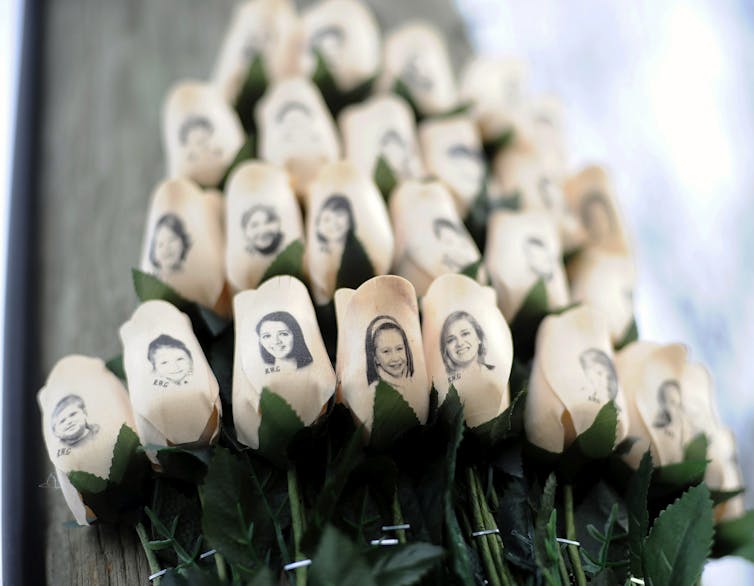
They were, of course, partly insulated from that risk. Their kids went to schools with better security than most; they had money and health insurance. But it was still a risk. They had been exposed to that risk directly.
The pervasiveness of the threat means that gun massacres can and do happen to people who are otherwise protected from the most excessive cruelties of American society. To take just one example: in 2017, a gunman opened fire on a mostly white crowd at a country music festival in Las Vegas. It was the deadliest mass shooting in American history.
They were all horrified by gun violence, of course. They were sad, and frightened. But they weren’t angry. They were resigned to the continuing occurrence of mass shootings of children: just another thing that happens in America.
Powerful Americans would see this as unfair, of course. But after nearly four years of reflection, I do not know what else to take from it. These enormously powerful and influential people had decided that not only was the risk worth it, but that they could do nothing about it.
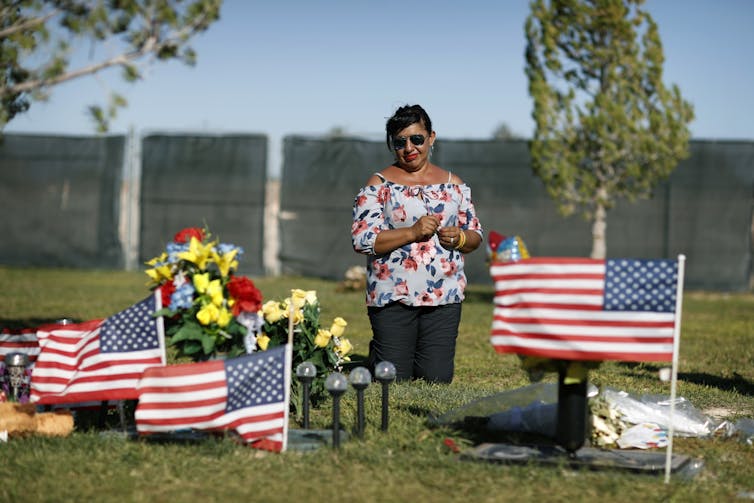
The result of that failure – of Yale, of the other Ivy Leagues, of the institutions of American political power – is a country awash with fear and violence. In the US there are more guns than people. Americans purchased 17 million guns in 2020, after Parkland; they already had 400 million. Put another way, five per cent of the world’s population owns 45 per cent of the world’s guns.
That population suffers from the highest rate of gun-related deaths in the developed world. Gun violence kills roughly 40,000 people every year. Gun violence is now the leading cause of death for American children. The guns that kill those children are manufactured by American companies deeply ingrained in the American military industrial complex. American capitalism is geared towards war.
The result of all this is also a powerful elite, riding the conduit from the Ivy Leagues to government and Wall Street, inured to violent death and absolved of personal responsibility.
‘The blob’ and institutionalised violence
That group of powerful people make up the courts, the government, and the “blob” — the foreign policy establishment made up of academics, think tanks, and government. The blob is what takes Americans to war, where they use weapons similar to, and worse than, the AR-15 that killed children at Marjory Stoneman Douglas High and at Sandy Hook Elementary.
The blob sends American men to fight unwinnable wars, where they shoot people with guns, and then some of them come back and threaten the very fabric of the democracy powerful Americans so revere and that they had promised to protect. One investigation found that nearly one in five of the assailants on the Capitol had a military history. Some of them were former or current law enforcement officers. Many of them were wearing military-grade body armour, just like the man in Ulvade.
Joe Biden’s “blob” might look and sound different to Donald Trump’s, but it won’t do anything to really address this violence. Biden’s blob is made up of the same kind of people who have failed to act before.
The 2020 Democratic Party Platform said all the right things about ending gun violence – about universal background checks and banning the manufacture of assault weapons. They invited X González, a Parkland survivor, to narrate a stirring video about gun violence at the 2020 Democratic National Convention. But even in that video, you could almost hear the resignation in González’s voice.
The President and First Lady visited Ulvade on Sunday. President Biden said all the right things; his grief was visceral, and genuine. But it all came, as CNN reported, “without promise of major legislative action to prevent further carnage”.
And Biden’s promise that he “will”, as one mourner begged him, “do something”, doesn’t factor in the prospect of the Democrats losing their tiny congressional majority in November. Lawmakers are in talks now, but even if they do keep their majority, holding a coalition of Democrats together to pass even the most basic of gun control measures would be incredibly difficult.
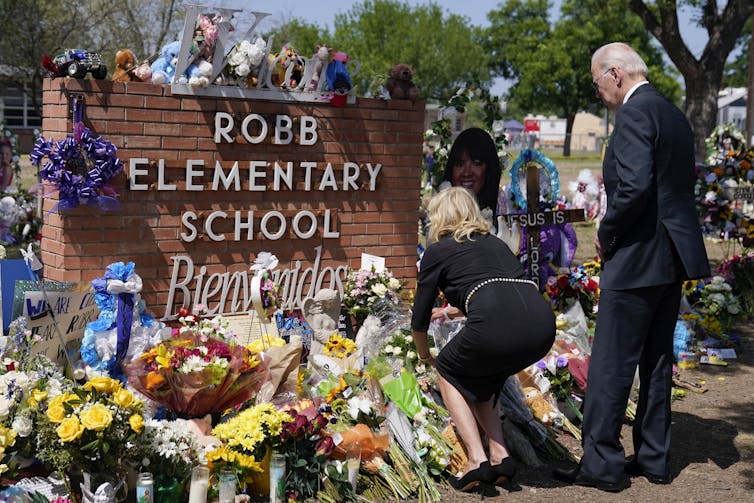
More broadly, none of this addresses the institutional failures that have let the gun lobby torpedo gun control efforts for decades. And it doesn’t reflect on the nature of American exceptionalism – on why 27 words written over 200 years ago hold American society hostage, and why powerful Americans allow that to continue.
It doesn’t address why those words are held up as uniquely good in the world, despite the way they are weaponised against Americans themselves. It doesn’t ask why it is that so many powerful Americans who know better – who know that most of the rest of the world doesn’t have to live with the very real threat of their children dying at school at the hands of their peers – have decided that that risk is worth it, for them and their fellow citizens.
That exceptionalism has allowed every generation of American children since Columbine in 1999 to face an existential threat in their own schools, in the full knowledge that the people who hold power and influence in their exceptional country are unable and unwilling to protect them.
This is Joe Biden’s “beacon”, Ronald Reagan’s “force for good in the world”. This is what American exceptionalism does, at home and abroad: it puts Americans on a permanent war footing, against each other – against their own children – and against outsiders. This is the true face of the country that rules our world.
Read more: The U.S. Capitol raid exposes the myth and pathology of American exceptionalism
In mid-2018, we drove out of New Haven for a weekend away in upstate New York. Summer had finally arrived, and everything was green and full of life. The drive was beautiful, not at all like the ten-lane American highways we had grown accustomed to, but tree-lined and skirting around rivers and lakes. Clara was asleep in the backseat as it dawned on the both of us where we were. As we followed the curves of Berkshire Road, we saw the signs for Newtown, and, a little later, Sandy Hook.
Nothing is worth that. Nothing.
An earlier version of this essay was shortlisted for the 2022 Calibre Essay Prize

